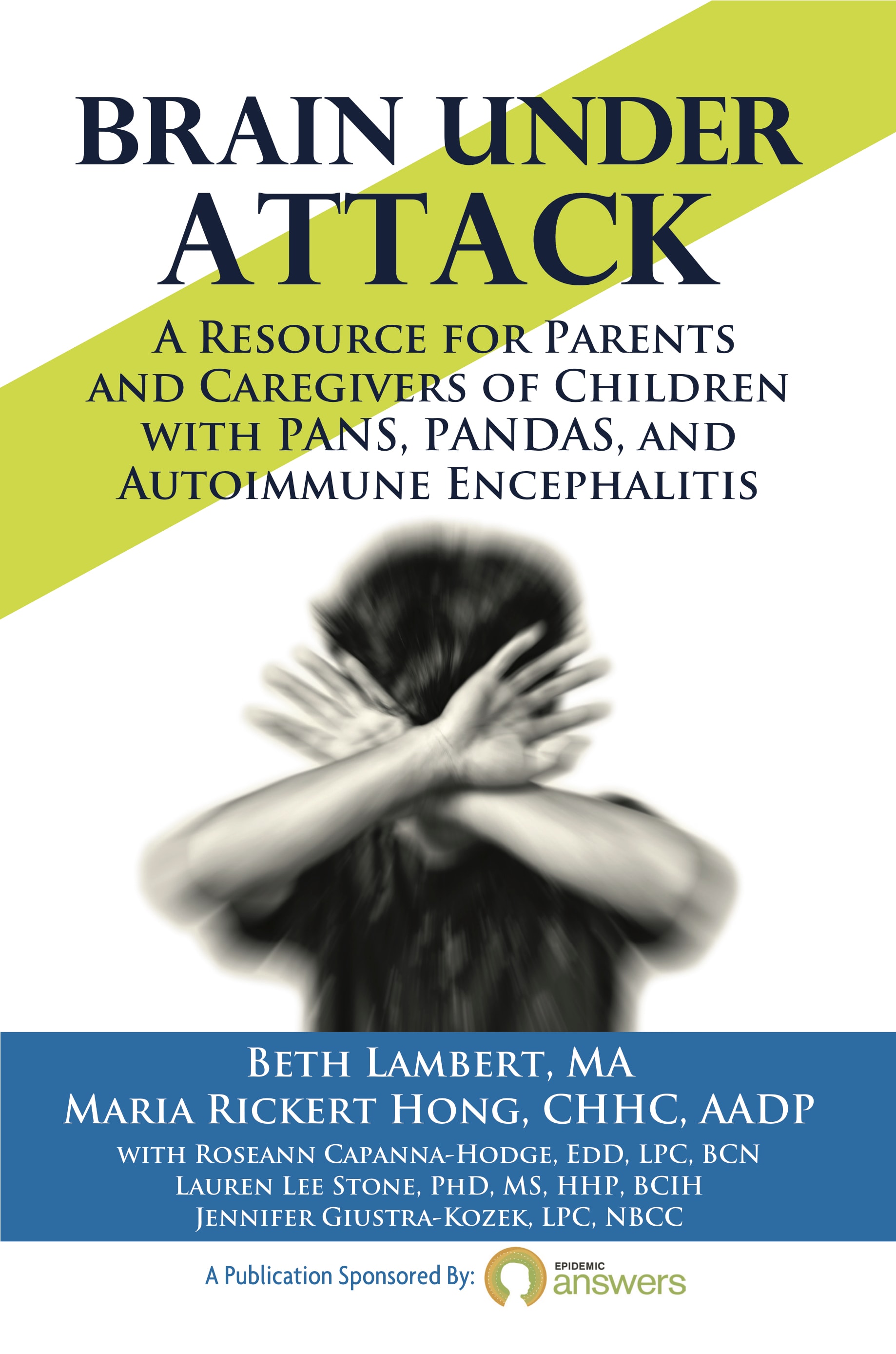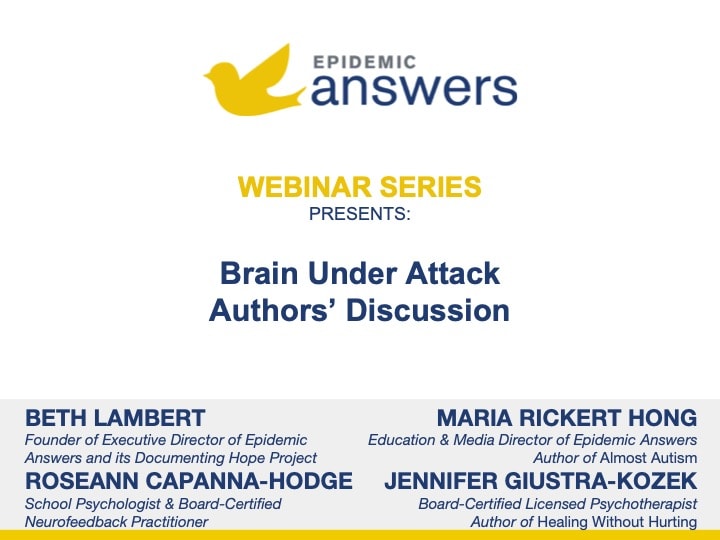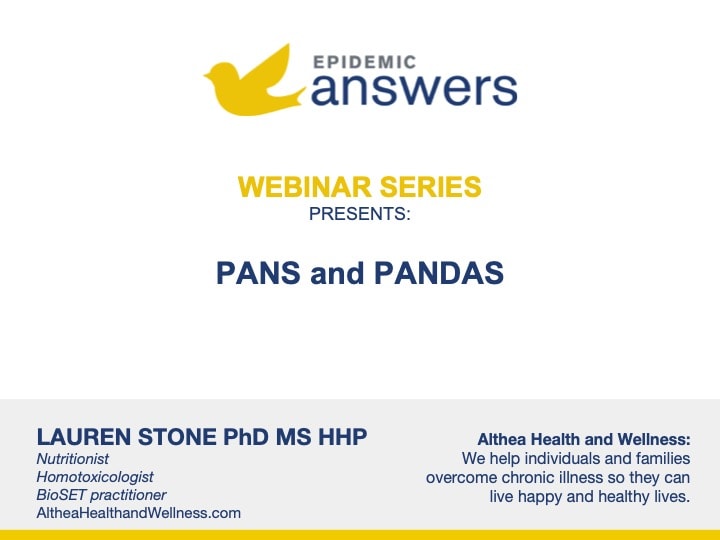Epidemic Answers’ book Brain Under Attack: A Resource for Parents and Caregivers of Children with PANS, PANDAS and Autoimmune Encephalitis is a must-read for parents of children with symptoms and diagnoses such as:
- OCD (Obsessive Compulsive Disorder)
- Lyme disease
- Excessive anxiety, especially separation anxiety
- Depression
- ODD (Oppositional Defiant Disorder)
- Tics such as:
- Hair pulling
- Eyelash pulling
- Motor tics
- Repetitive or compulsive coughing or throat-clearing when not sick
- Excessive temper tantrums
- Mood swings
- Behavioral regression
- Developmental regression
- Sensory processing difficulties
- Sleep problems
- Gastrointestinal pain
- Bedwetting
- Severe food restriction
- Anorexia
- Decline in handwriting skills
- Decline in math skills
- Hyperactivity
- Inability to concentrate
- Head banging
- Aggression
- Refusal to go to school
- Increased desire to be left alone
- Seizures
Parents of children with autism, ADHD, Sensory Processing Disorder and learning disabilities may also benefit from reading the book, as many children with these disorders may also have PANS.
PANS (Pediatric Acute-onset Neuropsychiatric Syndrome), also known as Autoimmune Encephalitis, can include infections that cross the blood-brain barrier such as:
- Group A Streptococcus
- Lyme disease and its co-infections
- Mycoplasma pneumoniae
- Varicella virus
- Influenza virus
- Epstein-Barr virus
- Herpes simplex virus
- Other herpetic viruses
In Brain Under Attack, you’ll read about:
- Why these infections are crossing the blood-brain barrier
- Common Western medical approaches to PANS
- Integrative approaches to PANS
- Interviews with practitioners of all types
- Interviews with parents who have restored the health of their children with PANS
- Diet and lifestyle recommendations for boosting your child’s immune system
If you are a practitioner and wish to buy the book in multiples of 20, Epidemic Answers is offering the book at a 40% discount to the book’s list price, exclusive of shipping.
Practitioners of children with these conditions may find the book helpful in educating parents of these children.
Still Looking for Answers?
Visit the Epidemic Answers Provider Directory to find a practitioner near you.
Sources & References
Aldad, T.S., et al. Fetal Radiofrequency Radiation Exposure From 800-1900 Mhz-Rated Cellular Telephones Affects Neurodevelopment and Behavior in Mice. Sci Rep. 2012;2:312.
Allen, A.J., et al. Case study: a new infection-triggered, autoimmune subtype of pediatric OCD and Tourette’s syndrome. J Am Acad Child Adolesc Psychiatry. 1995 Mar;34(3):307-11.
Arnold, P.D., et al. Is obsessive-compulsive disorder an autoimmune disease? Canadian Medical Association Journal. 2001 Nov 13;165(10):1353-8.
Baj, J., et al. Alterations in the Nervous System and Gut Microbiota after β-Hemolytic Streptococcus Group A Infection-Characteristics and Diagnostic Criteria of PANDAS Recognition. Int J Mol Sci. 2020 Feb 21;21(4):1476.
Banks, W.A., et al. Aluminum-induced neurotoxicity: alterations in membrane function at the blood-brain barrier. Neurosci Biobehav Rev. 1989 Spring;13(1):47-53.
Baytunca, M.B. [Evaluation of a Neuropsychiatric Disorder: From PANDAS to PANS and CANS]. Turk Psikiyatri Derg. 2016 Summer;27(2):0.
Bitnun, A., et al. Acute Childhood Encephalitis and Mycoplasma pneumoniae. Clin Infect Dis. 2001 Jun 15;32(12):1674-84.
Bjarnason, I., et al. Mechanisms of Damage to the Gastrointestinal Tract From Nonsteroidal Anti-Inflammatory Drugs. Gastroenterology. 2018 Feb;154(3):500-514.
Boileau, B. A review of obsessive-compulsive disorder in children and adolescents. Dialogues Clin Neurosci. 2011;13(4):401-11.
Bora, S.A., et al. Regulation of vitamin D metabolism following disruption of the microbiota using broad spectrum antibiotics. J Nutr Biochem. 2018 Jun;56:65-73.
Braniste, V., et al. The gut microbiota influences blood-brain barrier permeability in mice. Sci Transl Med. 2014 Nov 19;6(263):263ra158.
Bransfield, R.C., et al. The association between tick-borne infections, Lyme borreliosis and autism spectrum disorders. Medical Hypotheses. 2008;70(5):967-74.
Bravo, J.A., et al. Ingestion of Lactobacillus strain regulates emotional behavior and central GABA receptor expression in a mouse via the vagus nerve. Proc Natl Acad Sci U S A. 2011 Sep 20;108(38):16050-5.
Brown, K., et al. Pediatric Acute-Onset Neuropsychiatric Syndrome Response to Oral Corticosteroid Bursts: An Observational Study of Patients in an Academic Community-Based PANS Clinic. J Child Adolesc Psychopharmacol. 2017 Jul 17.
Brown, K.D., et al. Effect of Early and Prophylactic Nonsteroidal Anti-Inflammatory Drugs on Flare Duration in Pediatric Acute-Onset Neuropsychiatric Syndrome: An Observational Study of Patients Followed by an Academic Community-Based Pediatric Acute-Onset Neuropsychiatric Syndrome Clinic. J Child Adolesc Psychopharmacol. 2017 Jul 11.
Butel, M.J., et al. The developing gut microbiota and its consequences for health. J Dev Orig Health Dis. 2018 Mar 22:1-8.
Burkett, P.R., et al. Pouring fuel on the fire: Th17 cells, the environment, and autoimmunity. J Clin Invest. 2015 Jun;125(6):2211-9.
Calaprice, D., et al. A Survey of Pediatric Acute-Onset Neuropsychiatric Syndrome Characteristics and Course. J Child Adolesc Psychopharmacol. 2017 Jan 31.
Carpentier, A., et al. Clinical trial of blood-brain barrier disruption by pulsed ultrasound. Sci Transl Med. 2016 Jun 15;8(343):343re2.
Chang, K., et al. Clinical evaluation of youth with pediatric acute–onset neuropsychiatric syndrome (PANS): recommendations from the 2013 PANS Consensus Conference. J Child Adolesc Psychopharmacol. 2015 Feb;25(1):3-13.
Chiarello, F., et al. An expert opinion on PANDAS/PANS: highlights and controversies. Int J Psychiatry Clin Pract. 2017 Jun;21(2):91-98.
Connolly, A.M., et al. Serum autoantibodies to brain in Landau-Kleffner variant, autism, and other neurologic disorders. The Journal of Pediatrics. 1999 May;134(5):607-13.
Cooperstock, M., et al. Clinical Management of Pediatric Acute-Onset Neuropsychiatric Syndrome: Part III—Treatment and Prevention of Infections. J Child Adolesc Psychopharmacol. 2017 Jul, ahead of print.
Cosford, Robyn. Occult Infections, Streptococcus, Biofilms, PANDAS and MINDDD in Autism. Defeat Autism Now! Conference, San Diego, CA, Oct 2008.
Cox, C.J., et al. Antineuronal antibodies in a heterogeneous group of youth and young adults with tics and obsessive-compulsive disorder. J Child Adolesc Psychopharmacol. 2015 Feb;25(1):76-85.
Dahm, T., et al. Neuroinvasion and Inflammation in Viral Central Nervous System Infections. Mediators Inflamm. 2016;2016:8562805.
Dale, R.C., et al. Encephalitis lethargica syndrome: 20 new cases and evidence of basal ganglia autoimmunity. Brain. 2004 Jan;127(Pt 1):21-33.
Dale, R.C. Immune-mediated extrapyramidal movement disorders, including Sydenham chorea. Handb Clin Neurol. 2013;112:1235-41.
Dallasta, L.M., et al. Blood-Brain Barrier Tight Junction Disruption in Human Immunodeficiency Virus-1 Encephalitis. Am J Pathol. 1999 Dec;155(6):1915-27.
Das, T., et al. Influence of Calcium in Extracellular DNA Mediated Bacterial Aggregation and Biofilm Formation. PLoS One. 2014 Mar 20;9(3):e91935.
Dasdaq, S., et al. Effects of 2.4 GHz radiofrequency radiation emitted from Wi-Fi equipment on microRNA expression in brain tissue. Int J Radiat Biol. 2015 Jul;91(7):555-61.
DeLong, G.R., et al. Acquired reversible autistic syndrome in acute encephalopathic illness in children. Arch Neurol. 1981 Mar;38(3):191-4.
Ding, H., et al. Molecular Pathogenesis of Anti-NMDAR Encephalitis. Biomed Res Int. 2015;2015:643409.
Ercan, T.E., et al. Mycoplasma pneumoniae infection and obsessive-compulsive disease: a case report. J Child Neurol. 2008 Mar;23(3):338-40.
Endres, D., et al. Immunological causes of obsessive-compulsive disorder: is it time for the concept of an “autoimmune OCD” subtype? Translational Psychiatry. 12, Article number: 5 (2022).
Egset, K., et al. Magno App: Exploring Visual Processing in Adults with High and Low Reading Competence. Scandinavian Journal of Educational Research. 07 Jan 2020.
Feng, J., et al. Evaluation of Natural and Botanical Medicines for Activity Against Growing and Non-growing Forms of B. burgdorferi. Front. Med., 21 Feb 2020.
Ferretti, J.W., et al. Post-Streptococcal Autoimmune Sequelae: Rheumatic Fever and Beyond. Streptococcus pyogenes : Basic Biology to Clinical Manifestations [Internet]. 2016 Feb 10. Oklahoma City (OK): University of Oklahoma Health Sciences Center.
Fiorentino, M., et al. Blood–brain barrier and intestinal epithelial barrier alterations in autism spectrum disorders. Molecular Autism. 2016 Nov 29;7:49.
Frankovich, J., et al. Clinical Management of Pediatric Acute-Onset Neuropsychiatric Syndrome: Part II—Use of Immunomodulatory Therapies. J Child Adolesc Psychopharmacol. 2017 Jul
Frankovich, J., et al. Five youth with pediatric acute-onset neuropsychiatric syndrome of differing etiologies. J Child Adolesc Psychopharmacol. 2015 Feb;25(1):31-7.
Frankovich, J., et al. Multidisciplinary clinic dedicated to treating youth with pediatric acute-onset neuropsychiatric syndrome: presenting characteristics of the first 47 consecutive patients. J Child Adolesc Psychopharmacol. 2015 Feb;25(1):38-47.
Gaughan, T., et al. Rapid Eye Movement Sleep Abnormalities in Children with Pediatric Acute-Onset Neuropsychiatric Syndrome (PANS). J Clin Sleep Med. 2016 Jul 15;12(7):1027-32.
Gerardi, D.M., et al. PANDAS and comorbid Kleine-Levin syndrome. J Child Adolesc Psychopharmacol. 2015 Feb;25(1):93-8.
Gerentes, M., et al. Obsessive-Compulsive Disorder: Autoimmunity and Neuroinflammation. Curr Psychiatry Rep. 2019 Aug 1;21(8):78.
Ghaziuddin, M., et al. Brief report: autism and herpes simplex encephalitis. J Autism Dev Disord. 1992 Mar;22(1):107-13.
Gillberg, C. Onset at age 14 of a typical autistic syndrome. A case report of a girl with herpes simplex encephalitis. J Autism Dev Disord. 1986 Sep;16(3):369-75.
Goncalves, M.V.M., et al. Pediatric acute-onset neuropsychiatric syndrome (PANS) misdiagnosed as autism spectrum disorder. Immunol Lett. 2018 Nov;203:52-53.
Greer, M.K., et al. A case study of the cognitive and behavioral deficits of temporal lobe damage in herpes simplex encephalitis. J Autism Dev Disord. 1989 Jun;19(2):317-26.
Gulati, G., et al. Anti-NR2 antibodies, blood-brain barrier, and cognitive dysfunction. Clin Rheumatol. 2016 Dec;35(12):2989-2997.
Hacohen, Y., et al. N‐methyl‐d‐aspartate (NMDA) receptor antibodies encephalitis mimicking an autistic regression. Dev Med Child Neurol. 2016 Oct;58(10):1092-4.
Hadjivassiliou, M., et al. Gluten sensitivity: from gut to brain. Lancet Neurol. 2010 Mar;9(3):318-30.
Havas, M. Radiation from wireless technology affects the blood, the heart, and the autonomic nervous system. Rev Environ Health. 2013;28(2-3):75-84.
Hazlett, H.C., et al. Early brain development in infants at high risk for autism spectrum disorder. Nature. 2017 Feb 16;542:348–351.
Herbert, M.R., et al. Autism and EMF? Plausibility of a pathophysiological link part II. Pathophysiology. 2013 Jun;20(3):211-34.
Hirai, N., et al. A new infectious encephalopathy syndrome, clinically mild encephalopathy associated with excitotoxicity (MEEX). J Neurol Sci. 2017 Sep 15;380:27-30.
Hou, J., et al. Viral interactions with the blood-brain barrier: old dog, new tricks. Tissue Barriers. 2016 Jan 28;4(1):e1142492.
Ivanovski, I., et al. Aluminum in brain tissue in autism. J Trace Elem Med Biol. 2019 Jan;51:138-140.
Jain, R., et al. The effect of medical treatments on the bacterial microbiome in patients with chronic rhinosinusitis: a pilot study. Int Forum Allergy Rhinol. 2018 Mar 8.
Jaspers-Fayer, F., et al. Prevalence of Acute-Onset Subtypes in Pediatric Obsessive-Compulsive Disorder. J Child Adolesc Psychopharmacol. 2017 May;27(4):332-341.
Johansson, O. Disturbance of the immune system by electromagnetic fields—A potentially underlying cause for cellular damage and tissue repair reduction which could lead to disease and impairment. Pathophysiology. 2009 Aug;16(2-3):157-177.
Jyonouchi, H., et al. Cytokine profiles by peripheral blood monocytes are associated with changes in behavioral symptoms following immune insults in a subset of ASD subjects: an inflammatory subtype? J Neuroinflammation. 2014 Oct 27;11:187.
Kantarcioglu, A.S., et al. Microbiota-Gut-Brain Axis: Yeast Species Isolated from Stool Samples of Children with Suspected or Diagnosed Autism Spectrum Disorders and In Vitro Susceptibility Against Nystatin and Fluconazole. Mycopathologia. 2016 Feb;181(1-2):1-7.
Kelly, J.R., et al. Breaking down the barriers: the gut microbiome, intestinal permeability and stress-related psychiatric disorders. Front Cell Neurosci. 2015 Oct 14;9:392.
Khan, Z., et al. Slow CCL2-dependent translocation of biopersistent particles from muscle to brain. BMC Med. 2013 Apr 4;11:99.
Kim, C., et al. Strep and Urinary Frequency: Is There a Connection? New England Section of the American Urological Association, 75th Annual Meeting. 2006 Sep 28-30.
Kim., Y., et al. Obsessive-Compulsive Disorder Related to Mycoplasma-Associated Autoimmune Encephalopathy with Basal Ganglia Involvement. Child Adolesc Psychopharmacol. 2016 May;26(4):400-2.
King, L., et al. Intuition: a critical review of the research and rhetoric. J Adv Nurs. 1997 Jul;26(1):194-202.
Kinoshita, M., et al. Targeted delivery of antibodies through the blood-brain barrier by MRI-guided focused ultrasound. Biochem Biophys Res Commun. 2006 Feb 24;340(4):1085-90.
Kirvan, C.A., et al. Streptococcal mimicry and antibody-mediated cell signaling in the pathogenesis of Sydenham’s chorea. Autoimmunity. 2006 Feb;39(1):21-9.
Koffie, R.M., et al. Nanoparticles enhance brain delivery of blood–brain barrier-impermeable probes for in vivo optical and magnetic resonance imaging. Proc Natl Acad Sci U S A. 2011 Nov 15;108(46):18837-42.
Kovacevic, M., et al. Use of Intravenous Immunoglobulin in the Treatment of Twelve Youths with Pediatric Autoimmune Neuropsychiatric Disorders Associated with Streptococcal infections. J Child Adolesc Psychopharmacol. 2015 Feb;25(1):65-9.
Kurlan, R. Tourette’s syndrome and ‘PANDAS’: will the relation bear out? Pediatric autoimmune neuropsychiatric disorders associated with streptococcal infection. Neurology. 1998 Jun;50(6):1530-4.
Lancaster, E. The Diagnosis and Treatment of Autoimmune Encephalitis. J Clin Neurol. 2016 Jan;12(1):1-13.
Latimer, M.E., et al. Therapeutic plasma apheresis as a treatment for 35 severely ill children and adolescents with pediatric autoimmune neuropsychiatric disorders associated with streptococcal infections. J Child Adolesc Psychopharmacol. 2015 Feb;25(1):70-5.
Leclercq, S., et al. Low-dose penicillin in early life induces long-term changes in murine gut microbiota, brain cytokines and behavior. Nature Communications. 2017; 8.
Lionetti, E., et al. Gluten Psychosis: Confirmation of a New Clinical Entity. Nutrients. 2015 Jul 8;7(7):5532-9.
López-Aranda, M.F., et al. Postnatal immune activation causes social deficits in a mouse model of tuberous sclerosis: Role of microglia and clinical implications. Sci Adv. 2021 Sep 17;7(38):eabf2073.
Ludlow, A.K., et al. Understanding the impact of diet and nutrition on symptoms of Tourette syndrome: A scoping review. J Child Health Care. 2018 Mar;22(1):68-83.
Mahony, T., et al. Improvement of psychiatric symptoms in youth following resolution of sinusitis. Int J Pediatr Otorhinolaryngol. 2017 Jan;92:38-44.
Mahony, T., et al. Palatal Petechiae in the Absence of Group A Streptococcus in Pediatric Patients with Acute-Onset Neuropsychiatric Deterioration: A Cohort Study. J Child Adolesc Psychopharmacol. 2017 Apr 7.
Marcello, A., et al. Pediatric Autoimmune Neuropsychiatric Disorders Associated with Streptococcal Infections (PANDAS): An Evolving Concept. Tremor Other Hyperkinet Mov (N Y). 2013 Sep 25;3. pii: tre-03-167-4158-7.
Marquet, F., et al. Noninvasive, Transient and Selective Blood-Brain Barrier Opening in Non-Human Primates In Vivo. PLoS One. 2011;6(7):e22598.
Masand, P.S., et al. Prevalence of irritable bowel syndrome in obsessive-compulsive disorder. CNS Spectr. 2006 Jan;11(1):21-5.
Mason, R. Expanding Diagnostic Vision with Medical Intuition. Alternative and Complementary Therapies. 2009 Mar 19; 6(6).
Mink, J., et al. Acute postinfectious movement and psychiatric disorders in children and adolescents. J Child Neurol. 2011 Feb;26(2):214-7.
Moretti, G., et al. What every psychiatrist should know about PANDAS: a review. Clinical Practice and Epidemiology in Mental Health. 2008 May 21;4:13.
Morris, C.R., et al. Syndrome of allergy, apraxia, and malabsorption: characterization of a neurodevelopmental phenotype that responds to omega 3 and vitamin E supplementation. Alternative Therapies in Health and Medicine. Jul-Aug 2009;15(4):34-43.
Muir, K.E., et al. A case report of obsessive-compulsive disorder following acute disseminated encephalomyelitis. Pediatrics. 2013 Sep;132(3):e771-4.
Murphy, T.K., et al. Cefdinir for recent-onset pediatric neuropsychiatric disorders: a pilot randomized trial. J Child Adolesc Psychopharmacol. 2015 Feb;25(1):57-64.
Murphy, T.K., et al. Characterization of the pediatric acute-onset neuropsychiatric syndrome phenotype. J Child Adolesc Psychopharmacol. 2015 Feb;25(1):14-25
Murphy, T.K., et al. A Double-Blind Randomized Placebo-Controlled Pilot Study of Azithromycin in Youth with Acute-Onset Obsessive-Compulsive Disorder. J Child Adolesc Psychopharmacol. 2017 Mar 30.
Murphy, T.K., et al. Pediatric acute-onset neuropsychiatric syndrome. Psychiatr Clin North Am. 2014 Sep;37(3):353-74.
Nadeau, J.M., et al. A pilot trial of cognitive-behavioral therapy augmentation of antibiotic treatment in youth with pediatric acute-onset neuropsychiatric syndrome-related obsessive-compulsive disorder. J Child Adolesc Psychopharmacol. 2015 May;25(4):337-43.
Nicolson, G.L. Chronic Bacterial and Viral Infections in Neurodegenerative and Neurobehavioral Diseases. Lab Medicine. 2008;39(5):291-299.
Nicolson, G.L., et al. Chronic Mycoplasmal Infections in Autism Patients. Proc. Intern. Mind of a Child Conference, Sydney, Australia 2002.
Nicolson, G.L., et al. Evidence for Mycoplasma ssp., Chlamydia pneunomiae, and human herpes virus-6 coinfections in the blood of patients with autistic spectrum disorders. J Neurosci Res. 2007 Apr;85(5):1143-8.
Onalapo, A.Y., et al. Dietary glutamate and the brain: In the footprints of a Jekyll and Hyde molecule. Neurotoxicology. 2020 Sep;80:93-104.
Orefici, G., et al. Pediatric Autoimmune Neuropsychiatric Disorders Associated with Streptococcal Infections (PANDAS). Streptococcus pyogenes: Basic Biology to Clinical Manifestations [Internet]. Oklahoma City (OK): University of Oklahoma Health Sciences Center; 2016-. 2016 Feb 10.
Orlovska, S., et al. Association of Streptococcal Throat Infection With Mental Disorders: Testing Key Aspects of the PANDAS Hypothesis in a Nationwide Study. JAMA Psychiatry. 2017 Jul 1;74(7):740-746.
Pall, M.L. Microwave frequency electromagnetic fields (EMFs) produce widespread neuropsychiatric effects including depression. J Chem Neuroanat. 2016 Sep;75(Pt B):43-51.
Parker-Athill, E.C., et al. Cytokine correlations in youth with tic disorders. J Child Adolesc Psychopharmacol. 2015 Feb;25(1):86-92.
Pavone, P., et al. Anti-brain antibodies in PANDAS versus uncomplicated streptococcal infection. Pediatr Neurol. 2004 Feb;30(2):107-10.
Pearlman, D.M., et al. Anti-basal ganglia antibodies in primary obsessive-compulsive disorder: systematic review and meta-analysis. Br J Psychiatry. 2014 Jul;205(1):8-16.
Perlmutter, S.J., et al. Therapeutic plasma exchange and intravenous immunoglobulin for obsessive-compulsive disorder and tic disorders in childhood. Lancet. 1999 Oct 2;354(9185):1153-8.
Pihtili, A., et al. Evidence for the Efficacy of a Bioresonance Method in Smoking Cessation: A Pilot Study. Forsch Komplementmed. 2014;21(4):239-45.
Plioplys, A.V., et al. Anti-CNS antibodies in childhood neurologic diseases. Neuropediatrics. 1989 May;20(2):93-102.
Rawls, W.E., et al. Encephalitis associated with herpes simplex virus. Ann Intern Med. 1966 Jan;64(1):104-15.
Sahyouni, R., et al. Effects of concussion on the blood–brain barrier in humans and rodents. Journal of Concussion. 2017 Jan 1; 10.1177/2059700216684518
Sai, Y., et al. Clinical diagnosis and treatment of pediatric anti-N-methyl-D-aspartate receptor encephalitis: A single center retrospective study. Exp Ther Med. 2018 Aug;16(2):1442-1448.
Samsel, A., et al. Glyphosate, pathways to modern diseases III: Manganese, neurological diseases, and associated pathologies. Surg Neurol Int. 2015 Mar 24;6:45.
Sifra, S., et al. Treatment of PANDAS and PANS: a systematic review. Neuroscience & Biobehavioral Reviews. 2018 Mar;86:51-65.
Singer, H.S., et al. Moving from PANDAS to CANS. The Journal of Pediatrics. 2012 May; 160(5):725-731.
Song, Y., et al. Effects of acute exposure to aluminum on blood-brain barrier and the protection of zinc. Neurosci Lett. 2008 Nov 7;445(1):42-6.
Spartz, E.J., et al. Course of Neuropsychiatric Symptoms After Introduction and Removal of Nonsteroidal Anti-Inflammatory Drugs: A Pediatric Observational Study. J Child Adolesc Psychopharmacol. 2017 Jul 11.
Spindler, K.R., et al. Viral disruption of the blood-brain barrier. Trends Microbiol. 2012 Jun;20(6):282-90.
Swedo, S.E., et al. Clinical Presentation of Pediatric Autoimmune Neuropsychiatric Disorders Associated with Streptococcal infections in Research and Community Settings. J Child Adolesc Psychopharmacol. 2015 Feb;25(1):26-30
Swedo, S.E., et al. Identification of children with pediatric autoimmune neuropsychiatric disorders associated with streptococcal infections by a marker associated with rheumatic fever. Am J Psychiatry. 1997 Jan;154(1):110-2.
Swedo, S.E., et al. Overview of Treatment of Pediatric Acute-Onset Neuropsychiatric Syndrome. J Child Adolesc Psychopharmacol. 2017 Jul 19.
Tanaka, S., et al. Autoantibodies against four kinds of neurotransmitter receptors in psychiatric disorders. J Neuroimmunol. 2003 Aug;141(1-2):155-64.
Tang, J., et al. Exposure to 900 MHz electromagnetic fields activates the mkp-1/ERK pathway and causes blood-brain barrier damage and cognitive impairment in rats. Brain Res. 2015 Mar 19;1601:92-101.
Theoharides, T.C., et al. Neuro-inflammation, blood-brain barrier, seizures and autism. J Neuroinflammation. 2011 Nov 30;8:168.
Thienemann M., et al. Clinical Management of Pediatric Acute-Onset Neuropsychiatric Syndrome: Part I-Psychiatric and Behavioral Interventions. J Child Adolesc Psychopharmacol. 2017 Jul 19.
Tohidpour, A., et al. Neuroinflammation and Infection: Molecular Mechanisms Associated with Dysfunction of Neurovascular Unit. Front Cell Infect Microbiol. 2017 Jun 20;7:276.
Tona, J.T., et al. Impact of PANS and PANDAS Exacerbations on Occupational Performance: A Mixed-Methods Study. Am J Occup Ther. 2017 May/Jun;71(3):7103220020P1-7103220020P9.
Toufexis, M.D., et al. Disordered eating and food restrictions in children with PANDAS/PANS. J Child Adolesc Psychopharmacol. 2015 Feb;25(1):48-56.
Tuchscherr, L., et al. Staphylococcus aureus phenotype switching: an effective bacterial strategy to escape host immune response and establish a chronic infection. EMBO Mol Med. 2011 Mar;3(3):129-41.
Venâncio, P., et al. Anti-N-methyl-D-aspartate receptor encephalitis with positive serum antithyroid antibodies, IgM antibodies against mycoplasma pneumoniae and human herpesvirus 7 PCR in the CSF. Pediatr Infect Dis J. 2014 Aug;33(8):882-3.
Vitaliti, G., et al. A new clinical feature associated with familial early-onset of dystonic-guttural tics: An unusual diagnosis of PANDAS. J Pediatr Neurosci. 2014 Jan;9(1):79-81.
Warner, B.B. The contribution of the gut microbiome to neurodevelopment and neuropsychiatric disorders. Pediatr Res. 2019 Jan;85(2):216-224.
Xu, C.L., et al. Anti-N-methyl-D-aspartate receptor encephalitis with serum anti-thyroid antibodies and IgM antibodies against Epstein-Barr virus viral capsid antigen: a case report and one year follow-up. BMC Neurol. 2011 Nov 29;11:149.
Xu, J., et al. Antibodies From Children With PANDAS Bind Specifically to Striatal Cholinergic Interneurons and Alter Their Activity. Am J Psychiatry. 2021 Jan 1;178(1):48-64.
Waites, K.B., et al. Mycoplasma pneumoniae and its role as a human pathogen. Clin Microbiol Rev. 2004 Oct;17(4):697-728.
Wang, Hsiuying. Anti-NMDA Receptor Encephalitis. Int J Mol Sci. 2017 Jan 18;18(1). pii: E193..
Yaddanapudi, K., et al. Passive transfer of streptococcus-induced antibodies reproduces behavioral disturbances in a mouse model of pediatric autoimmune neuropsychiatric disorders associated with streptococcal infection. Mol Psychiatry. 2010 Jul;15(7):712-26.
Zong, S., et al. Neuronal Surface Autoantibodies in Neuropsychiatric Disorders: Are There Implications for Depression? Front Immunol. 2017 Jul 5;8:752.
Resources
Books
Blaylock, Russell L. Excitotoxins: The Taste That Kills. Health Press, 1996.
Cahalan, Susannah. Brain on Fire: My Month of Madness. Simon & Schuster, 2013.
Campbell-McBride, Natasha. Gut and Psychology Syndrome: Natural Treatment for Autism, Dyspraxia, A.D.D., Dyslexia, A.D.H.D., Depression, Schizophrenia. 2010.
Chutkin, Robin. The Microbiome Solution: A Radical New Way to Heal Your Body from the Inside Out. Avery, 2016.
Lambert, Beth, et al. Brain Under Attack: A Resource for Parents and Caregivers of Children with PANS, PANDAS, and Autoimmune Encephalitis. Answers Publications, 2018.
Maloney, Alison Beth. Saving Sammy: A Mother’s Fight to Cure Her Son’s OCD. Broadway Books, 2010.
O’Hara, Nancy. Demystifying PANS/PANDAS: A Functional Medicine Desktop Reference on Basal Ganglia Encephalitis. DPWN Publishing, 2022.
Weiss, Melanie S. In a Pickle Over PANDAS. First Edition Design Publishing, 2015.
Websites
New England PANS/PANDAS Association
Videos
PANDAS and PANS with Amy Joy Smith, NP on BetterHealthGuy.com




